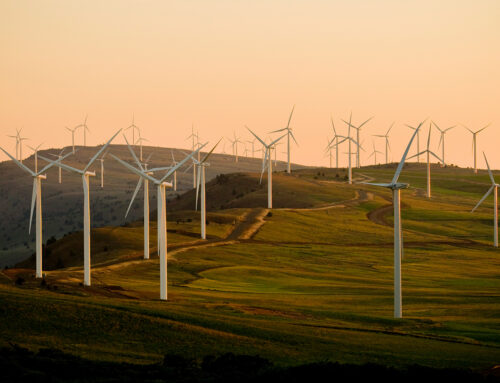Can Mamdani supercharge New York’s clean energy revolution?
November 19, 2025
On one of the first chilly nights of fall, union members, Democratic Socialists, scientists, and teachers filed into the pews of a Brooklyn church for what they called the “People’s Hearing for Public Renewables.” Zohran Mamdani — fresh off winning his Democratic primary, and expected to become the next mayor of New York City — wasn’t there, but he loomed over the festivities Many in the crowd believed they were on the verge of finally gaining an ally with the power to help achieve their longstanding goal: A New York almost entirely powered by publicly owned and regulated renewable energy.
New York’s public-renewables campaign “was instrumental in getting Zohran elected,” state Assemblymember Marcela Mitaynes said of Mamdani’s primary win that night. They want an expanded public power system, utilities and renewable generation owned and regulated by community stakeholders, not corporations. That campaign, which began in earnest four years ago, was driven by a small group of progressive and socialist legislators in Albany: among them, Zohran Mamdani, who was elected to the Assembly in 2020. He has since rallied that same base – experienced canvassers, people used to hiking up six-floor walk-ups and texting their friends to rally for a policy or for a candidate – for his election as mayor.
Your support powers solutions-focused climate reporting — keeping it free for everyone. All donations DOUBLED for a limited time. Give now in under 45 seconds.
Secure · Tax deductible · Takes 45 Seconds
Stories like this don’t tell themselves.
Make others like it possible. Your support powers solutions-focused climate reporting — keeping it free for everyone. Give now in under 45 seconds.
Secure · Tax deductible · Takes 45 Seconds
Now, with Mamdani about to take office, the question is whether he and the state can deliver on those hopes. The mayor’s office doesn’t lead public power projects. That job belongs to the New York Power Authority, a state agency established in 1931 as an early experiment in publicly owned power generation and a model for more widely known projects like the Tennessee Valley Authority. Throughout the 20th century, the agency built transmission infrastructure, backed massive hydropower projects, and led energy efficiency initiatives in state buildings.
In more recent years, proponents of publicly-owned green energy sometimes saw the New York Power Authority as less of an ally and more of a stumbling block. But in 2023, the Legislature passed the Build Public Renewables Act, or BPRA, which requires the New York Power Authority to fast-track and finance clean energy projects – enough of them, the law said, to power 70 percent of the state by 2030. Now, the question is if and when that law will be enforced.
In July, the authority released a plan to build 7 gigawatts of solar and wind with battery storage. Critics of that plan – many of whom helped write and pass the BPRA in the first place — say that isn’t enough electricity to meet statewide energy needs, or to comply with law’s 2030 deadline. In 2023, the state comptroller reported the ambitious 70 percent goal would require the state to at least triple its renewables capacity – at that point, only about 25 percent of New York’s energy came from renewables, largely hydroelectric power. That number hasn’t budged much – and last year, a state agency estimated that the authority would need another three years to meet the 2030 deadline.
Nonetheless, with a powerful ally about to take office, activists like Johanna Bozuwa, executive director of the Climate and Communities Institute, think now is a “key moment” to push the power authority forward NYPA. With federal tax credits for clean power set to expire in 2027, “they have a real incentive, right now, to move as quickly as they can. If there was ever a moment for them to mobilize as quickly as possible, this is the one to do it.” So, on that brisk September night in Brooklyn, public power activists wanted to use the moment of Mamdani’s win to tell the New York Power Authority to go even further: instead of a 7 gigawatt plan, they wanted 15.
Mamdani won’t have a direct hand in how the power authority executes the Build Public Renewables Act, but as mayor of the largest city in the nation, he can shape where and how New York City supports the transition. Much of what he can do resides on the consumer end: not just helping build more public power, but limiting the city’s consumption of it. His administration could require rooftop-solar installations on municipal buildings, align city permitting and zoning with state clean energy priorities, and use his Green Schools plan to advance the agenda. Mamdani can also control the enforcement of Local Law 97 – a city mandate that buildings larger than 25,0000 square feet nearly halve their emissions by 2030. For activists, that makes City Hall a crucial partner.
“I often call schools the charismatic megafauna of building decarbonization,” Bozuwa said: they’re places where students, parents, and teachers interact, and where other members of the community might go to vote, attend a town hall, or otherwise participate in the world beyond their home and their job. “I really see this as a key opportunity for the incoming administration to showcase the power of collaboration with an entity like NYPA, to leverage its power and relationships to decarbonize these schools.” The Connecticut Green Bank already has a similar program, Bozuwa said. “So, it’s a model that exists already — putting public renewables on top of public schools.” And in New York, similar programs already exist on a smaller scale: the New York Power Authority is working with a city agency to place solar panels on 47 schools.
The Authority’s board will vote on their next strategic plan December 9th. “The plan will be updated regularly, and it is anticipated that projects will continually be added or fall out during the project development process,” NYPA spokesperson Susan Craig said.
But the current funding environment for clean-power projects is hostile. Some experts believe the current seven-gigawatt plan is too ambitious, and that the power authority simply “can’t achieve those types of objectives,” as one former member of the state’s Climate Action Council told Inside Climate News. Others are concerned that proposing too much too fast might jeopardize the agency’s bond rating, leaving it less able to finance future projects.
And only three days after Mamdani’s election, Governor Kathy Hochul granted a thrice-rejected permit for the Northeast Supply Enhancement, a proposed fracked gas pipeline that would add to a 10,000-mile network stretching from Texas to New York, clearing the path for the state to rely even more on fossil fuels than it has in previous years.
Although climate was a key issue for Mamdani during his five years in the Assembly, he said little about it on the campaign trail. Still, his election has raised expectations among climate advocates — and questions about how much he can actually change. New York City remains far more dependent on fossil fuels than the rest of the state, largely because transmission bottlenecks prevent the renewable power generated update from coming in, and the city has not met its own clean energy goals to transition to 100% clean energy by 2040. “It’s like a tale of two grids,” Andrea Johnson, a researcher with the Public Power New York Coalition, said. But a state-local partnership to deliver more clean power, cut consumption of that power, and maybe even lower bills doesn’t seem entirely unlikely.
This wouldn’t be the first time New York City has partnered with a state agency to achieve climate goals. This year alone, the power authority has worked with New York Public Schools to install energy-efficient lighting throughout the school system – lighting the agency said will eventually save the city about $10 million annually. It has joined with the city’s housing authority to replace gas stoves in 10,000 apartments with energy-efficient induction models, as they announced November 13th. And these collaborations go back decades: in the 1990s, for example, an energy-efficient-refrigerator program that began with power authority funding in New York City public housing ended up paving the way for development of a refrigerator design that used 30 percent less energy than the Department of Energy’s standard at the time. The city could look to a similar model to purchase subsidized heat pumps for buildings struggling to comply with emissions standards – but in order to lower electricity bills across the board, Mamdani’s administration will need to solve the generation end of the puzzle, too. So far, NYPA has signed on to build one major solar array within New York City limits: a ten-megawatt cluster of panels at a wastewater treatment facility.
When Mamdani’s first mayoral budget proposal comes out at the beginning of February, we may see the first signs of how this new administration plans to build on those efforts. With a city budget shortfall of $5 to $8 billion, threats from President Donald Trump to cut off billions in federal aid to New York City and the state, and lawmakers in Albany anxious about overspending. But selling climate policy as affordability policy is a strategy that’s recently paid big dividends.
“We can’t disaggregate climate from cost of living,” Bozuwa said. “The Mamdani administration really has the opportunity to show what a new form of climate politics looks like, one that actually brings climate and cost of living together.”
Search
RECENT PRESS RELEASES
Related Post



